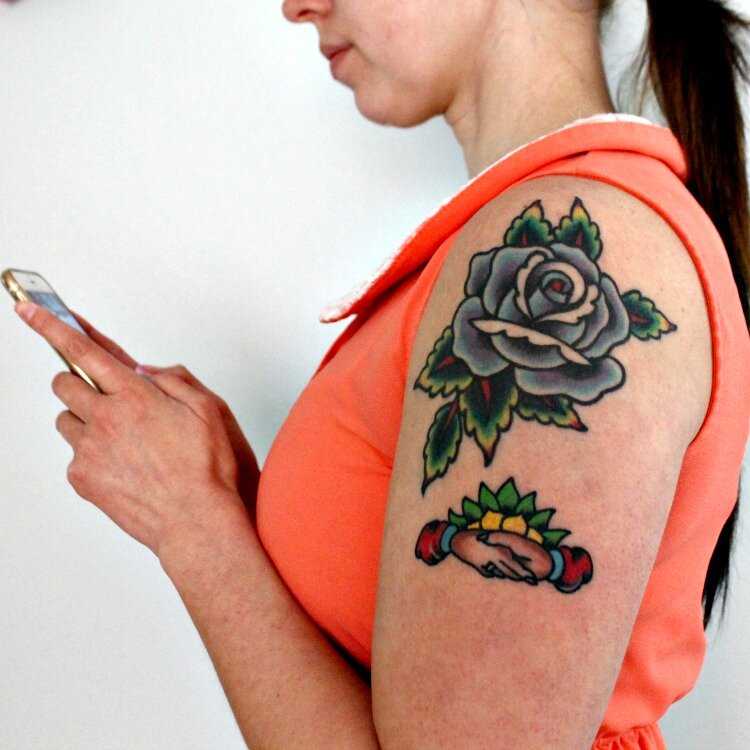When it comes to social media, your bio is like a book cover. It might be a better practice for people to actually scroll through your tweets or your Instagram posts to get a feel for whether or not they’d like to follow you. But most people really just look at your bio and make a snap judgement.
That’s why your bios on social media are So. Important.
You’ve got super limited space to tell people what you’re all about and why they should follow you. This is not (and shouldn’t be) an exact science. In fact, I’ve been known to change my bios pretty regularly (not that I would necessarily recommend that, but you know how that goes…). But there are some definite common links between a lot of really strong bios, especially when it comes to bloggers/small businesses.
Over my several years of using social media, following lots of awesome people, reading lots of awesome bios, and writing some of my own – here’s what I’ve come up with:
How to Write Social Media Bios That Get Results
Get straight to the point
All those people you’re trying to connect with on social media have their own lives and their own things going on. They don’t have all the time in the world to sit around reading through lengthy bios on social media.
So keep it quick! Don’t just make sure that your bio is under the required character limit or word count. But get straight to the point. Right away.
Your first word or your first sentence should say what you do and why anyone should care. There’s no need to build up to it.
Stay away from generalities
How often do you see the following words in social media profiles?
- Entrepreneur
- Business Owner
- Expert
- Lifestyle Blogger
Probably all the time, right? Those types of general terms might have their place when it comes to describing you and what you do. But you have to spice them up if you want anyone to really take notice.
How do you do this?
Get more specific and add your own flare to those descriptions. Instead of saying you’re a lifestyle blogger, niche down or call out some of the specific things that you write about.
Maybe you blog about a lot of things, but a lot of it is fashion/style oriented – you could call yourself a “fashionable lifestyle blogger,” “stylish lifestyle blogger,” or “blogger covering fashion, style, and …” Even just getting a little more specific can help people get to know you a little better and differentiate your profile. (Note: you’ll need to get even more specific than those titles above – but we’ll get to that!)
Call out your target audience
You might think that your social media bios should be all about you. But you’re missing out on one key thing.
Who is it that you’re trying to connect with on social media? Don’t just let people decide for themselves if they’re the type of person who should connect with you. Tell them!
So in our “lifestyle blogger” example, we could say that you’re trying to connect with millennial women in larger cities.
Here’s what the first part of your bio might look like:
Stylish blogger covering everything from food to fashion. Giving millennial women a guide to big city life.
So when those members of your target audience come across your bio, they think, “hey, that’s me!” And they’ll be even more likely to want to connect with you.
Don’t forget about keywords!
This is a basic part of writing any bio. But it can get lost in the shuffle with all the other tips. It might seem kind of icky – but it’s important! Don’t forget to include relevant keywords in your bio so that people searching within your niche can really easily find you.
If you follow all the other tips on this list, including keywords shouldn’t even be difficult. It’s honestly just a part of accurately describing yourself and what you do. Just don’t get too cutesy with your wording. Calling yourself a sartorial wordsmith isn’t exactly going to help you get found when people who are looking for fashion bloggers to follow are probably going to search for “fashion blogger.”
In the example above, we have the keywords “blogger,” “fashion” and “millennial women” all accounted for. Depending on the site, you might have a little bit more room to add others. But for sites where you have to keep it short, like Twitter and Instagram, a few keywords can do the trick.
Include some personality
Another way you can set yourself apart from all those other people in your niche is by adding some personality to your profile.
If you’re writing a bio for your personal social media accounts, this should be simple. You can add something about a hobby, a show you like, or something that you regularly post about.
For example, say you’re writing your Twitter profile, and you sometimes share photos of your cute dog in tweets, when you’re not tweeting about fashion or blogging.
Your profile could look something like this:
Stylish blogger covering everything from food to fashion. Giving millennial women a guide to big city life and lots of cute dog pics.
Call your followers to action
Next, figure out what you want people to do upon reading your bio. And then straight up ask them to do that.
For example, if your only goal is to get people to click that FOLLOW button, you could change your bio to look like:
Stylish blogger covering everything from food to fashion. Giving millennial women a guide to big city life. Follow for blog updates and lots of cute dog pics.
Or maybe your goal is to get people to sign up for your email list. In that case, you could use the last line in your bio to add a call to action, with a relevant incentive.
Here’s an example:
Stylish blogger covering everything from food to fashion. Giving millennial women a guide to big city life and lots of cute dog pics. Click this link for your free NYC travel guide.
Then, make sure to include a relevant link that will drive the results you’re really looking for.
Make it specific to the platform
This is just a general guide for social media platforms. But there are some different things to account for on each individual platform, depending on which ones you use. For example, Twitter has a really short character limit, so you might have to consolidate. And with Instagram, you only get that one link in your profile, so you can add a short blurb about that specific link at the end of your bio.
It’s usually good practice to have some common links between your bios on all of those different platforms. It’s good for branding and all that stuff – so when people come across your bio on different platforms they know right away who you are. But having slight variances can be good and even necessary. So don’t be afraid to adapt!
Don’t follow a specific formula
Here’s the thing – I really believe in all of the tips I’ve listed here. But you have to find something that works for you specifically. Don’t just go, “well, Annie said that I have to say who I am first, then call out my target audience, then add a sentence about dogs…” etc.
Following any specific formula for your bio, whether it comes from me or someone else, is just going to result in your bio sounding exactly like everyone else’s. I think that’s why so many people’s bios right now sound like “Helping [target audience] do [whatever task] so they can [make x amount of money] and live their best lives.” Have you noticed that?
It’s great that those bios get super specific and all – but it’s so common! I don’t know about you, but I want to follow people who are actually interesting on social media. So play around with it. Write some bad bios and eventually you’ll write a really good one. I know it!
Do you have any other tips to share for writing awesome social media bios?
P.S. Grab my free starter’s guide to Instagram and other awesome resources by signing up here!




